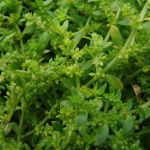| Common Name: |
Rupturewort |
| Botanical Name: |
Herniaria glabra |
| Genus: |
Herniaria |
| Family: |
Caryophyllaceae |
| Cultivation: |
Well-drained, dry, sandy, neutral to alkaline soil in sun. Tolerates poor soil. |
| Propagation: |
By seed sown in spring. |
| Harvest: |
Plants are cut during the growing season and used fresh in infusions and poultices. |
| Native Location: |
W, C, and S Europe, N Africa, and Asia |
| Height: |
4cm (1½in) |
| Width: |
30cm (12in) |
| Hardiness: |
Z5 |
| Parts Used: |
Whole plant |
| Properties: |
An astringent, diuretic herb that has mild anti-spasmodic effects, especially on the kidneys. |
| Medicinal Uses: |
Internally for urinary and kidney problems, fluid retention, neuritis, and neural mucus, arthritis, and rheumatism. Externally to heal ulcers. |
| Bibliography: |
Encyclopedia of Herbs by Deni Brown. Copyright © 1995, 2001 Dorling Kindersley Limited. pg 234
|

